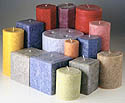
Selling and Marketing Candles (Revisited)
Selling and Marketing Candles (Revisited)
If your retail sales are flat, it may be time to look back one of our most successful articles that involved Selling and Marketing candles. This article was the first in a three-part series. The issues actually may even be more timely now then ever. Despite the focus on selling candles, even the hobbyist/crafter can benefit by much of the information contained in this article.
 One of the most appealing things to us has always been the ability for a candle company to compete in certain markets, regardless of their size. Even the smallest candle maker has the ability to succeed because of their personal attention, potential for offering a wide range of fragrances and colors, and their ability to react to small orders in a rapid manner.
One of the most appealing things to us has always been the ability for a candle company to compete in certain markets, regardless of their size. Even the smallest candle maker has the ability to succeed because of their personal attention, potential for offering a wide range of fragrances and colors, and their ability to react to small orders in a rapid manner.
When starting out it would be best to service local accounts such as your small gift store, family-owned pharmacies, furniture stores and even consignment shops. These venues are always a good starting point since in most instances you will be dealing directly with the owner. By selecting local markets, you have the ability to deliver the product, thus eliminating freight cost (this will be covered later). You also have the ability to work out arrangements with the owner to track their inventory level. And finally, many of these types of business enjoy the fact that the candles are made locally and they will promote that fact.
You may want to look at local craft and art shows. This is always a good starting point to build local interest in your products. It also provides a good forum to find what your potential customer may desire.
A well-designed web site is always a good idea too. However, keep in mind that many candle companies have their own web site, thus it is hard to get your product in the forefront. While eBay does not really need an endorsement, many candle companies find this to be a very successful place when starting out. Listing costs are very low and many potential customers can view your products.
Another good source for selling candles is through fundraisers with local organizations. This is a “win-win” situation for both parties since payment typically is received at the time goods are sold. This lets you start to build a local following in the community with the fund raising organization serving as sales representatives. The good thing is that after the event is over, many people still will be interested in purchasing your candles.
One critical element is not to over extend yourself or take on orders that are well beyond your production capability. While it is always very appealing to have your product accepted into mass retailers, it can hurt a growing or small company. In many instances it is very difficult for smaller companies to have the same purchasing power as the larger ones when purchasing the waxes, scents and colors.
Keep your material costs under control.
It comes as a shock to many candle companies that when making a highly scented candle, the scent can cost more than the wax itself. Selecting the percentage of scent used and where you purchase your scents is critical in controlling cost. The determination on how much scent to use is almost always a personal preference decision. During this determination process, you should keep in mind that scents do have a point of diminishing return. This means you could probably get the same scent throw with 6% as you would with the 8% scents. However, this difference will make a sizeable impact on the cost of the finished candles. You should go through this process with each fragrance you use. As you probably have found, certain fragrances by nature are stronger than others, i.e. cinnamon fragrances, mulberry and French vanilla all have a tendency to have a stronger impact.

A 3-wick candle using F-Wax natural wax.
When purchasing waxes, you have two options—blended waxes or straight paraffins. You should select the one that works better for you at the most efficient price. As a small candle company you may also want to explore candles that the larger companies are not as effective in making, i.e. natural candles, chunk candles and other specialty type candles.
Once you have selected your wax, one of the key aspects is shipping. It is important that you control this aspect as much as possible. Undoubtedly, the price per pound for shipping wax is much higher than most other products. Therefore, it is important that you look at each pricing level when making that determination. You may have to purchase more up front but you will save both on the discounts offered on the wax and the shipping. For example 200 pounds of wax shipped at one time is approximately 16% less than if you were to get 2 shipments of 100 pounds each. If you are able to take 500 pounds it is 45% less for shipping than if you took 5 shipments of 100 pounds!
To summarize some of the points identified, it is imperative that you review all costs—both direct and indirect costs. Some of your indirect costs will include items such as inner/master cartons, labeling requirements, skids and utilities. While individually they are not a lot they can add up over a number of candles.
